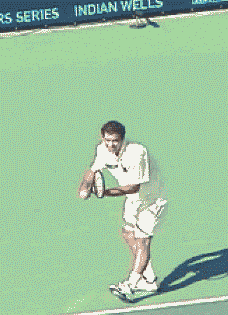<% ns_puts [mkm_getnavbar] %>

Advanced Tennis:
Sampras Serve - The Tossing Motion
by John Yandell
Throw the ball up in the air and hit it. The
bio-mechanics of the serve seem complex, but how difficult can the toss
possibly be?
Ask Pat Rafter, who continually apologizes to opponents, ďSorry, mate,Ē when he catches another errant toss - or Karol Kuchera, who caught so many tosses he drove Andre Agassi crazy at the U.S. Open. (Agassi lost the match - the first time a bad toss ever worked as a weapon.)
|
As with so many other aspects of his serve, Pete Samprasís tossing motion is an excellent technical model for developing a consistent toss. But the ďtossingĒ arm, or the opposite arm, also has a significant - and controversial - role to play in the continuation of the motion after the toss. Sampras also provides a perfect model for the motion of the opposite arm after the toss and as it moves through the rest of the swing.
Think about the toss closely. The ball has to be in precisely the right place for the contact point to be exactly right - on every serve. Itís a skill equivalent to juggling - the ability to throw a small round ball to a precise spot in space, over and over again.
Many players achieve good ball placement on the toss only sporadically. Others actually develop fundamental technical swing problems directly related to a poor toss. A good serve and a good toss are interrelated and inter-dependent. If the toss isnít positioned properly, itís impossible to achieve the three core positions in the swing - the racket drop, the contact, and the followthrough - detailed in the previous article. These elements are the fundamentals for racket head speed. (See Part 2).
The Height of the Toss
Unfortunately, the best known and most often repeated theory of the toss is actually counter-productive and the cause of many basic serving problems. ďHit the ball at the top of the toss.Ē Thatís a common tip repeated by players, teaching pros and television commentators. The model commonly pointed to is Roscoe Tanner, the great American player of the 1970ís and 1980ís, who had a particularly low toss. But Tanner was a rarity, one of a very, very few top players ever to toss the ball so low.
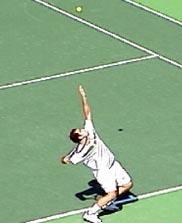 |
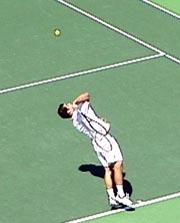 |
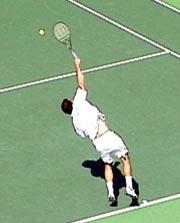 |
Like good servers at all levels, Peteís tosses well above the contact point, so that the ball drops more than a foot before the hit. |
||
Advanced Tennis analysis shows Pete Samprasí toss drops more than a
foot before contact, about the same as the great John McEnroe (For more
information on Advanced Tennis, click
here). I havenít
seen a player on the tour in several years who actually hit the ball at
the top of the toss, have you? (Ok, maybe Conchita Martinez, but do you
want her serve?)
In addition to his high toss, Sampras maintains great
tossing arm extension. As with all great servers, Sampras finishes with
his tossing arm fully extended, pointing almost directly upward.
He then holds this position for a distinct interval before the arm
starts to fall downward and across the torso.
|
The same qualities are shared by the vast majority of
past and current pro players - as well as thousands of successful
competitive players at all levels. Virtually
all good servers toss the ball one foot to several feet above the contact
point, and then hold the tossing arm at extension.
Remember Ivan Lendl? Steffi
Graf? Boris Becker?
Television commentators continually criticized their high tosses, but they
just kept serving well and winning matches. Thinking about it, you can
probably visualize the image of their tossing arms pointing straight up
with the ball high in the air prior to the hit.
Are the vast majority of players with high tosses all technically wrong? Should the average player develop a radically different, super low toss instead? Whatís the relationship between the toss height and a good technical motion anyway?
The key to understanding the height of the toss is
the rhythm of the individual server. The height of the toss
determines the interval of the motion - the time a player has to execute
the swing pattern. The higher the
toss, the more time the player has to move through the core positions we've
examined in the last article.
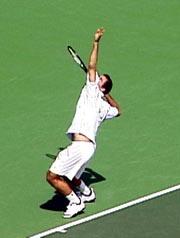
The more you coil and use your legs and body for power, the more important a high toss becomes. |
Some players, even at the height of the pro game,
simply need more time than others to move through these positions.
The height of your toss has to be matched to your personal serving
rhythm, so you can move through the core positions, stay relaxed, and
develop velocity through the natural acceleration of the racket head. If
so many top players need high tosses in order to execute a full, smooth
swing, how much more so the average player!
In addition, the more deeply you bend your knees, the more you coil your body for power instead of just using your arm, the more time you will need. And this means tossing higher. We will explore these advanced elements later in our series.
Roscoe Tannerís ultra low toss and fast rhythm were the exception not the rule - maybe with a slightly higher toss and a slower rhythm, he would have served higher percentages in big matches - like his Wimbledon final loss to Bjorn Borg.
Click here for Page 2
To view the complete ProStrokes Gallery of digitally mastered Pete Sampras serves, click here.
For more information on John Yandell's Advanced Tennis, click here.
Your comments are welcome. Let us know what you about think John Yandell's article by emailing us here at TennisONE.
Last Updated 7/15/00. To contact us, please email to: webmaster@tennisone.com
TennisONE is a registered trademark of TennisONE and SportsWeb ONE; Copyright 1995. All rights reserved.

